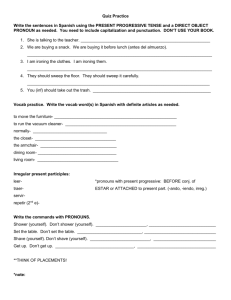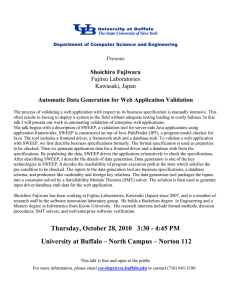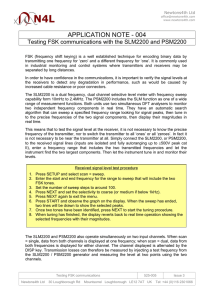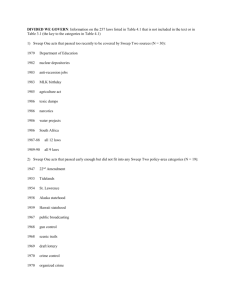Document 10615686
advertisement
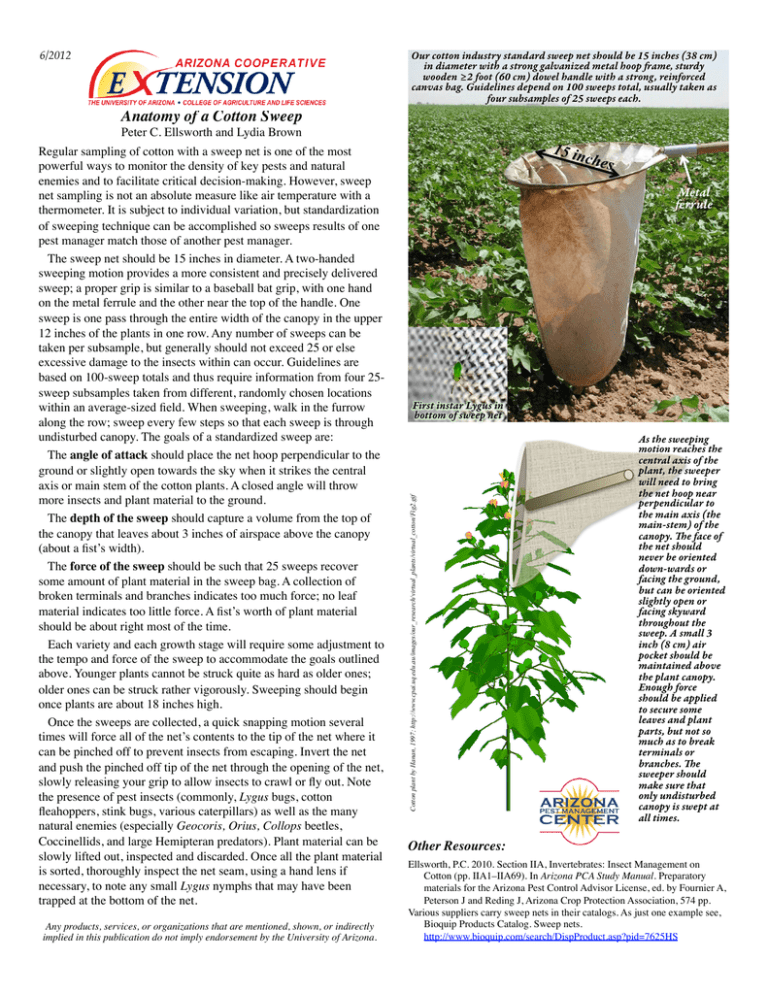
6/2012! Our cotton industry standard sweep net should be 15 inches (38 cm) in diameter with a strong galanized metal hoop ame, sturdy wooden ≥2 foot (60 cm) dowel handle with a strong, reinforced canas bag. Guidelines depend on 100 sweeps total, usually taken as four subsamples of 25 sweeps each. Anatomy of a Cotton Sweep Peter C. Ellsworth and Lydia Brown Any products, services, or organizations that are mentioned, shown, or indirectly implied in this publication do not imply endorsement by the University of Arizona. 15 in ches Metal ferrule First instar Lygus in bottom of sweep net Cotton plant by Hanan, 1997; http://www.cpai.uq.edu.au/images/our_research/virtual_plants/virtual_cotton/Fig2.gif Regular sampling of cotton with a sweep net is one of the most powerful ways to monitor the density of key pests and natural enemies and to facilitate critical decision-making. However, sweep net sampling is not an absolute measure like air temperature with a thermometer. It is subject to individual variation, but standardization of sweeping technique can be accomplished so sweeps results of one pest manager match those of another pest manager. The sweep net should be 15 inches in diameter. A two-handed sweeping motion provides a more consistent and precisely delivered sweep; a proper grip is similar to a baseball bat grip, with one hand on the metal ferrule and the other near the top of the handle. One sweep is one pass through the entire width of the canopy in the upper 12 inches of the plants in one row. Any number of sweeps can be taken per subsample, but generally should not exceed 25 or else excessive damage to the insects within can occur. Guidelines are based on 100-sweep totals and thus require information from four 25sweep subsamples taken from different, randomly chosen locations within an average-sized field. When sweeping, walk in the furrow along the row; sweep every few steps so that each sweep is through undisturbed canopy. The goals of a standardized sweep are: The angle of attack should place the net hoop perpendicular to the ground or slightly open towards the sky when it strikes the central axis or main stem of the cotton plants. A closed angle will throw more insects and plant material to the ground. The depth of the sweep should capture a volume from the top of the canopy that leaves about 3 inches of airspace above the canopy (about a fist’s width). The force of the sweep should be such that 25 sweeps recover some amount of plant material in the sweep bag. A collection of broken terminals and branches indicates too much force; no leaf material indicates too little force. A fist’s worth of plant material should be about right most of the time. Each variety and each growth stage will require some adjustment to the tempo and force of the sweep to accommodate the goals outlined above. Younger plants cannot be struck quite as hard as older ones; older ones can be struck rather vigorously. Sweeping should begin once plants are about 18 inches high. Once the sweeps are collected, a quick snapping motion several times will force all of the net’s contents to the tip of the net where it can be pinched off to prevent insects from escaping. Invert the net and push the pinched off tip of the net through the opening of the net, slowly releasing your grip to allow insects to crawl or fly out. Note the presence of pest insects (commonly, Lygus bugs, cotton fleahoppers, stink bugs, various caterpillars) as well as the many natural enemies (especially Geocoris, Orius, Collops beetles, Coccinellids, and large Hemipteran predators). Plant material can be slowly lifted out, inspected and discarded. Once all the plant material is sorted, thoroughly inspect the net seam, using a hand lens if necessary, to note any small Lygus nymphs that may have been trapped at the bottom of the net. As the sweeping motion reaches the central axis of the plant, the sweeper will need to bring the net hoop near perpendicular to the main axis (the main-stem) of the canopy. e face of the net should never be oriented down-wards or facing the ground, but can be oriented slightly open or facing skyward throughout the sweep. A small 3 inch (8 cm) air pocket should be maintained aboe the plant canopy. Enough force should be applied to secure some leaves and plant parts, but not so much as to break terminals or branches. e sweeper should make sure that only undisturbed canopy is swept at all times. Other Resources: Ellsworth, P.C. 2010. Section IIA, Invertebrates: Insect Management on Cotton (pp. IIA1–IIA69). In Arizona PCA Study Manual. Preparatory materials for the Arizona Pest Control Advisor License, ed. by Fournier A, Peterson J and Reding J, Arizona Crop Protection Association, 574 pp. Various suppliers carry sweep nets in their catalogs. As just one example see, Bioquip Products Catalog. Sweep nets. http://www.bioquip.com/search/DispProduct.asp?pid=7625HS
